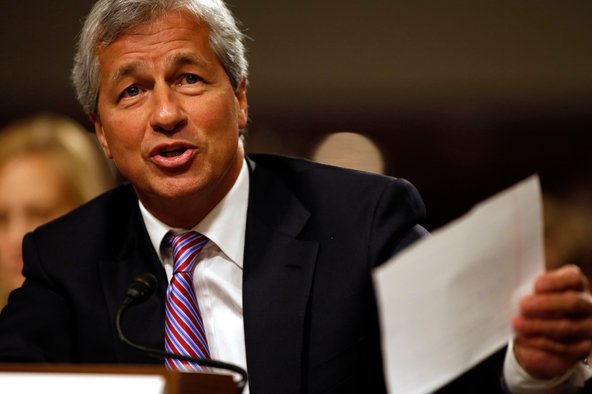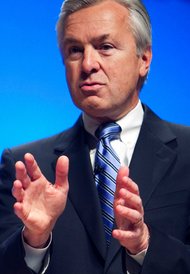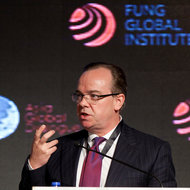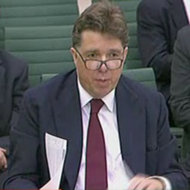 Larry Downing/ReutersJamie Dimon, the chief executive of JPMorgan Chase, reported a 33 percent increase in first-quarter earnings on Friday.
Larry Downing/ReutersJamie Dimon, the chief executive of JPMorgan Chase, reported a 33 percent increase in first-quarter earnings on Friday.
Wall Street knew the craze wouldn’t last.
The nation’s biggest banks, capitalizing on government efforts to bolster the housing market, have raked in handsome mortgage profits of late. On Friday, that started to change.
Wells Fargo, the nation’s largest home lender, disclosed that it originated fewer home loans and recorded lower mortgage banking income in the first quarter of 2013. JPMorgan Chase, the biggest bank by assets, reported limited appetite for new mortgages and a drop in mortgage banking income.
Since the 2008 financial crisis, the banks’ mortgage business had hinged on government intervention rather than fresh demand from consumers. When the Federal Reserve cut interest rates in recent years, it spurred millions of borrowers to refinance their home loans to reduce costs.
Now, as mortgage rates inch upward from their lows late last year and refinancing enthusiasm wanes, the pipeline of borrowers is drying up.
“You need a next level of people that are willing to buy and that simply isn’t there,” said J. J. Kinahan, a strategist at TD Ameritrade.
Banks are more optimistic, arguing that demand for new home mortgages will replace the refinancing frenzy. The banks, in predicting a continued housing recovery, point to their declining mortgage litigation costs and the increase in car lending and credit card spending.
 John Adkisson/ReutersJohn G. Stumpf, Wells Fargo’s chief executive, posted a 22 percent rise in earnings for the quarter.
John Adkisson/ReutersJohn G. Stumpf, Wells Fargo’s chief executive, posted a 22 percent rise in earnings for the quarter.
“People are buying cars, taking vacations and doing things to help fuel the economy,” John G. Stumpf, Wells Fargo’s chief executive, said in an interview. While noting that “the country has been through a shock” in the aftermath of the 2008 financial crisis, he argued that “you will see different loan categories start to grow.”
And despite the sluggish mortgage business, the banks showed broader signs of strength on Friday and managed to report record overall profits. JPMorgan posted a 33 percent jump in first-quarter earnings, to $6.53 billion, or $1.59 a share. Those results exceeded Wall Street analysts’ expectations of $1.40 a share.
Wells Fargo announced a 22 percent increase in earnings, to $5.17 billion, or 92 cents a share. The results outpaced estimates of analysts polled by Thomson Reuters, who had forecast earnings of 88 cents a share. For Wells, which is based in San Francisco, it was the 13th consecutive rise in quarterly earnings and the eighth consecutive record.
But revenue declined at both banks. And investors seemed skeptical about the banks’ returns. Shares in both banks fell, with JPMorgan dropping 30 cents, or 0.61 percent, to $49.01, and Wells Fargo sliding 30 cents, or 0.8 percent, to $37.21.
The results of both banks represented a turning point for their mortgage business. That business has been especially lucrative of late, as the banks pass on most loans to government entities like Fannie Mae and Freddie Mac, which guarantee the loans will be repaid. Armed with the guarantee, the banks package and sell the mortgages to investors for a significant profit.
The Federal Reserve has also stoked a refinancing boom after keeping interest rates at record lows. But the results on Friday signaled that those gains were unsustainable.
Underscoring a slowdown in refinancing, Wells Fargo said those loans accounted for 65 percent of mortgage originations in the first quarter, down from 76 percent in the period a year earlier. The bank’s mortgage banking income also slipped 3 percent, presenting potential problems for Wells Fargo, whose fortunes rise and fall with the mortgage market. And while handling $109 billion in mortgage originations might be a feat for some banks, it was a 16 percent drop for Wells Fargo.
JPMorgan’s mortgage originations actually soared 37 percent, but new loan applications slipped 8 percent from the fourth quarter. In total, the mortgage banking group posted a profit of $673 million for the first quarter, down 31 percent from a year earlier.
Still, JPMorgan’s chief executive, Jamie Dimon, struck a confident tone about the housing market.
“We are seeing positive signs that the economy is healthy and getting stronger,” Mr. Dimon said. “Housing prices continued to improve, and new home purchases are also starting to come back.”
He argued, however, that new regulations had clogged the lending spigot. The government’s lending standards remain too tough, he said, excluding some qualified borrowers from the market.
With the mortgage business in transition, the banks found other ways to burnish profits. For one, they cut expenses. Both banks also notched big gains in credit card and automobile lending. At JPMorgan alone, car lending grew 12 percent from a year earlier, to $6.5 billion.
JPMorgan’s results were also buoyed by gains in the investment banking business, where fees rose 4 percent, to $1.4 billion. The asset management business, which JPMorgan has expanded as regulations crimp other areas of the bank, reported net income of $487 million for the quarter, up 26 percent from a year earlier.
The gains were further fueled by JPMorgan’s decision to reduce reserves for mortgages and credit card loans. By moving money from the reserves, which cushion the bank against potential losses, the bank collected a net gain of 18 cents a share.
Addressing questions on Friday about whether the earnings are deceptively strong, Mr. Dimon said in a conference call that even after the reserve reductions, “we had really good numbers everywhere.”
At Wells Fargo, the strong returns were spread across the bank. Wholesale banking, which includes the sales and trading business along with the corporate lending division, reported that profits rose 9 percent. The bank also posted a 14 percent profit gain in its wealth management business. And profit in the community banking division, which includes Wells Fargo’s retail branches and consumer lending business, climbed 24 percent, to $2.9 billion.
“Wells Fargo’s diversified business model continued to produce outstanding results,” said Timothy J. Sloan, the bank’s chief financial officer.
A version of this article appeared in print on 04/13/2013, on page B1 of the NewYork edition with the headline: Drop in Home Loans Takes Toll on Banks.
Article source: http://dealbook.nytimes.com/2013/04/12/fewer-home-loans-start-to-affect-banks/?partner=rss&emc=rss

